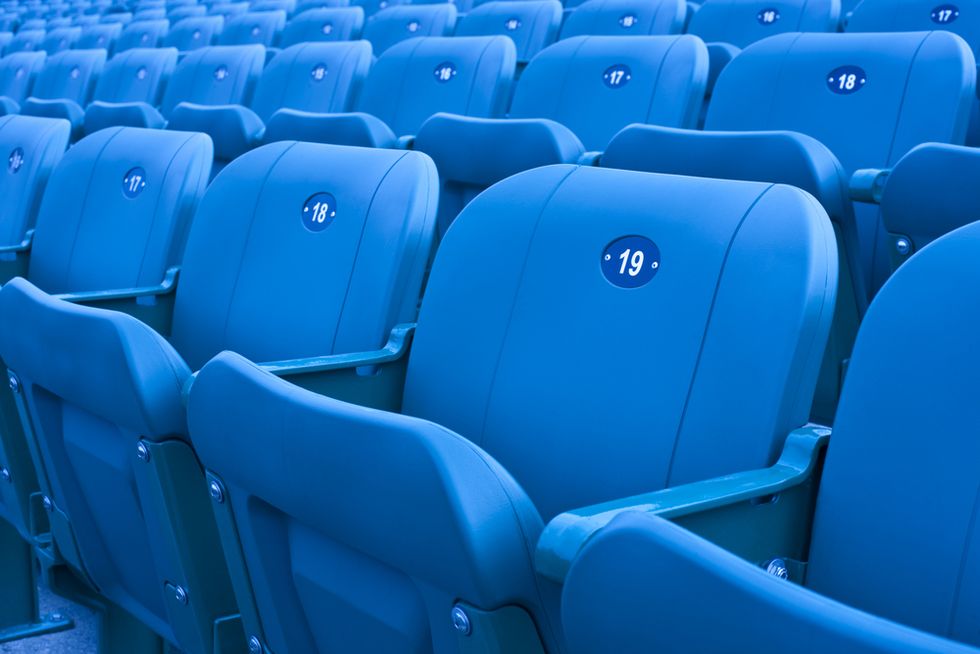
Photo credit: Shutterstock

SAN FRANCISCO (TheBlaze/AP) — Everyone in California is trying to get creative in their efforts to save water and meet conservation targets set by the state amid a historic drought. Some of this creativity is hitting places you might not have thought about before.
Like your baseball stadium seats.
If you find your seat a tad sticky, dirty and not its usual tidy plastic self, this could be because some fields are cutting back on power spraying after events.
The San Francisco Giants, for example, are pressure-washing its green seats only every other game. Thus, soda spills, gooey nacho cheese or stray garlic fries might be staying put a little longer in the stands these days. Team officials are even considering asking fans to clean up their own food and beverage messes.
A couple of hours before first pitch, members of the cleaning crew walk through the stands with spray bottles and hand towels to touch up and wipe down the seats where needed. Later, the video board implores: "BE A TEAM PLAYER, HELP THE GIANTS CONSERVE WATER!" That is followed by an announcement about keeping the ballpark tidy to reduce postgame cleansing.
Earlier this season, the grounds crew that watches over the lush green field where the Giants play tried cutting back on overnight watering. But that tactic didn't last.
The ground felt a little bit hard to the World Series champions and could have made players more prone to injury without some give in the grass.
"It's a serious drought," Giants manager Bruce Bochy said of the conservation efforts. "It's tough to not have the proper amount of water on the ball field. Some of these balls, as hard as they're hit, it gets dangerous and puts the infielders at risk."

Keeping the AT&T Park field soft with minimal watering is a tough balance and constant work-in-progress for head groundskeeper Greg Elliott and the Giants staff that takes prides in a pristine and playable surface.
Elliott hasn't watered his lawn at home in three years. The grass at his office, though, requires daily attention to host 81 regular-season home games each year plus regular playoffs. He has spent years developing creative ways of maintaining the field while using less water — much less.
"I have the worst lawn in the neighborhood," Elliott said recently while sitting in the Giants' dugout. "That's my lawn, and I run this lawn."
Across the bay, the Oakland Coliseum sits 22 feet below sea level and thus requires less water because the field holds the moisture better. The A's also find ways to cut down water usage by not spraying down the stands as regularly while still keeping the facility sanitary.
"We try not to use any water on the infield dirt while the team's on the road," head groundskeeper Clay Wood said. "As a common practice we try to conserve as much as we can. We have for the last five or six years since we started this drought. We have to find that balance."
At new $1.3 billion Levi's Stadium in Santa Clara, where the San Francisco 49ers play, recycled water is used for the plumbing system and to irrigate grass among other things — accounting for about 85 percent of total water usage. Synthetic turf was recently installed around high-traffic areas at the outer edges of the field to replace grass.
At Petco Park, the Padres say they conserved approximately 288,000 gallons of water during the offseason by not maintaining the playing field grass and they expect similar savings next offseason. The San Diego club shut down the water wall at the home plate gate and replaced the exterior landscape with drought-tolerant plants and materials, such as decomposed granite.
In Orange County, the Angels are evaluating ways to reduce water.
"It's a topic of discussion and a big agenda item for us," said Vice President of Communications Tim Mead.
At AT&T Park, Elliott has been preparing for a possible drought along with his boss, Jorge Costa, and the rest of the grounds crew for years now. The Giants spent money on wetting agents that bind to soil particles and keep the ground moist for longer periods. They base overnight watering of the outfield grass from not only careful observation but also computer-monitored tests.
On May 20, Elliott figured he'd need less water considering mist hovered low for most of the night during a Dodgers-Giants game.
"You wouldn't know that they're doing anything different than they've always done," Giants general manager Bobby Evans said.
Elliott relies on 10 field sensors that feed data to a computerized program that updates him to determine daily watering decisions before he leaves each night around 11:30 p.m. The infield clay is typically left alone, even when the team is away, until several touch-ups are necessary on game day.
"If you see us with a hose, it's probably a good thing," Elliott said.
Pitcher Matt Cain appreciates the planning and execution. Except for that feedback early on the grounds staff received about the field being a bit hard, generally, players barely notice any changes.
"They've been doing it without us having to really notice anything that's different. That's impressive," Cain said. "That's awesome."
—
Front page image via Shutterstock.